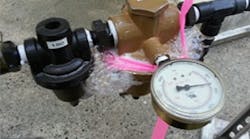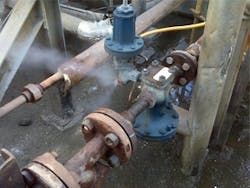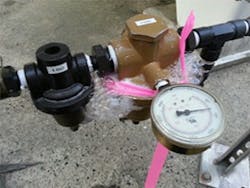|
More Ways to Cut Energy Consumption Overhead leaks: Consider using a parabolic dish or long-range module for long-distance identification of overhead steam leaks in pipe-racks or manifolds. Tip: Be aware that drips and water puddles on the ground are generally due to leakage points in the overhead steam or condensate return system. Seals and gaskets: Scan flash recovery systems, pressure reducing valve gaskets, and pump seals for leakage.Coal fineness: Acoustic emissions based on the coal hitting the ducts of the feed to the boilers can help determine the fineness of the coal. The pulverized particulate size or fineness will dramatically affect combustion efficiency and unburned carbon in the fly-ash. Creating a baseline reading and then monitoring periodic readings for a change in decibel levels can assist facilities in recognizing changes in the particle size of the coal.Natural gas to boilers, furnaces, and HVAC systems: Scan the natural gas lines, regulator gaskets, flanges, and pipe thread connections just as you would compressed air systems for leaks.And more: Scan coils in HVAC systems, rotary joints to cylinder dryers, humidifier connections, syphon tube connections, and heat exchanger tube bundles. |
If you’ve already instituted a steam trap testing program, then you’ve taken the first step in recognizing the importance of conserving the fuel to power your boiler. Presumably you own two important tools: an ultrasonic testing instrument and a handheld infrared thermometer. Let's explore some of the other uses in your steam system. Creative users are sure to invent many more.
Bypass valves around steam traps or control valves should be checked for leakage. They can easily be wiredrawn because of operator error — failure to tightly snug hand-wheels — or seat erosion. These valves have the potential to cause huge loss of revenue if they are passing steam. Imagine a ¾-in. bypass mistakenly left open during a startup for a prolonged period of time.
Control valves may be leaking through because of seats that may have become wiredrawn. Check for proper seat closure as you would steam traps. When control valves are not protected by proper drip legs, there’s a greater possibility that wiredrawing will occur. Wiredrawing is an effect of an etching that takes place between the close tolerances of head and seat when condensate in the steam passes through close tolerances at high velocity. The water cuts small microscopic marks on the seat that eventually do not allow for full valve closure. Therefore, it would be a wise practice to ultrasonically test the valves periodically for passage of steam when they should be shut. Touch the upstream and downstream sides and the closure point with the stethoscope, or contact, module to test for leakage. If the valves have rubber diaphragms, use the airborne module to scan for external leakage.
Relief valves should be tested as any other steam valve or steam trap (Figure 1). First see if any leakage is occurring at the downstream vent line. Listen to the relief valve and determine if leakage across the seat has occurred. Look for visual signs of leakage, such as condensing at the drip pan.
Figure 1. The large gasket leak in this steam pressure reducing valve (PRV) started off as an extremely small leak that was first identified months in advance with ultrasound.
Scan the external fitting and gaskets of all components of a vacuum system. Leakage can dramatically affect the proper operation of this system. Use the scanning module for external leaks and your stethoscope module to test for internal leakage. For low-level leaks there are specialty modules for close-up scanning to help identify these leaks. Vacuum leaks in a steam system may occur at steam turbine packing glands; steam jet ejectors (flange connections); venturi ejectors (weld leaks or points of erosion); or vacuum furnace piping and connections.
Packing glands or flange leaks can be real energy wasters in the steam system. They start off generally as small leaks and then escalate into larger leaks. Packing glands of control valves and shutoff valves should all be scanned with an airborne scanning module. Listen for turbulence, which will have a similar sound to that of a normal air or gas leak. Be sure to scan the gaskets of your air-operated control valves.
Figure 2. The gasket leak of this natural gas valve, feeding a steam unit heater, was identified with ultrasound. Soapy water was sprayed on it to show the leak site was at a dried out and cracked gasket.
Loose check valves, whether they are swing or lift types, make a distinctive clicking or rattling noise when they are loose. To test, touch the check valve with the tip of stethoscope module. Be aware, when loose check valves go unrepaired, the risk of having them eventually break apart becomes a threat.
Shaft packing leaks around steam turbines can be especially annoying and difficult to detect. Ultrasound scanning with the airborne module has proven quite effective in identifying leakage (Figure 2). There are specialized modules for challenging leak environments. Check to see if the manufacturer of your ultrasonic scanner offers a choice of modules to help in these situations.
Solenoids can be damaged or fail due to normal wear. Dirty systems may see solenoids clog or stuck open by debris. Often solenoids can be found in banks of several or more. Use a stethoscope module to determine if they are open when they should be closed. Use your airborne scanning module to see if any gasket or O-ring leaks exist.
Boiler casings may develop hairline cracks in them from fatigue. Use your airborne scanning module to scan the exterior of the boiler for small leaks.
Insulation in your steam system is only effective if it stays dry. Leaks under insulation may be identified by scanning system steam distribution piping with your airborne scanning module.
Cavitation in pumps occurs by the formation and collapse of vapor pockets or bubbles on the blade of an impeller. This can cause pitting on the surface of impellers or casing. Pump cavitation can usually be identified by touching the casing of centrifugal pumps with the stethoscope module. The collapse of the bubbles makes a distinctive and recognizable sound.
For proven ideas on other ultrasound applications, see the stories on presentations from UE Systems’ Ultrasound World X, where industry experts shared their successes. Take a look at the live coverage at http://www.plantservices.com/articles/2014/live-coverage-ultrasound-world-reliable-asset-world.



